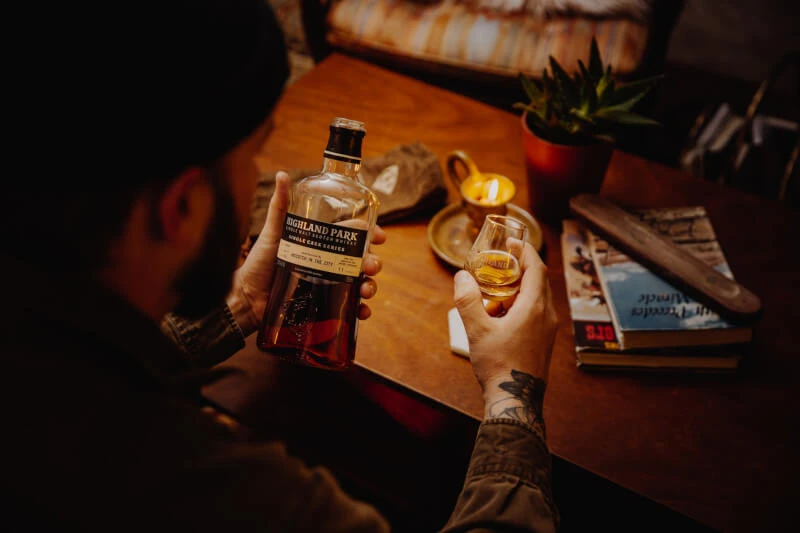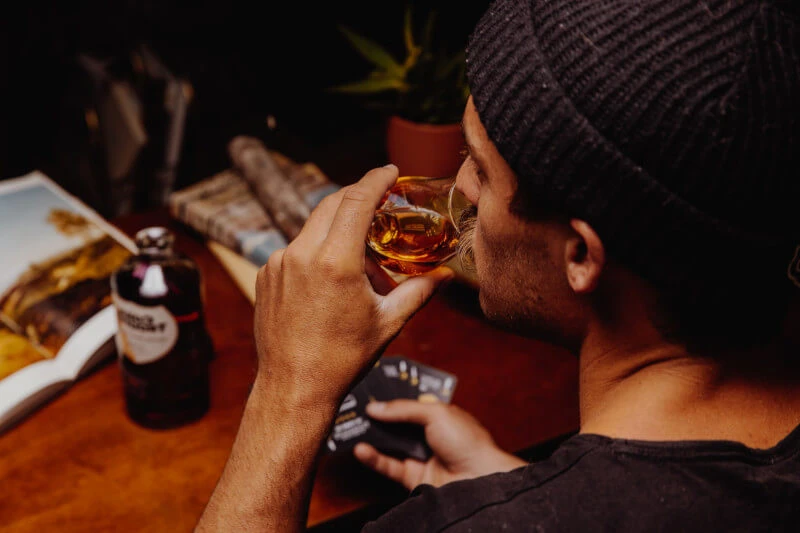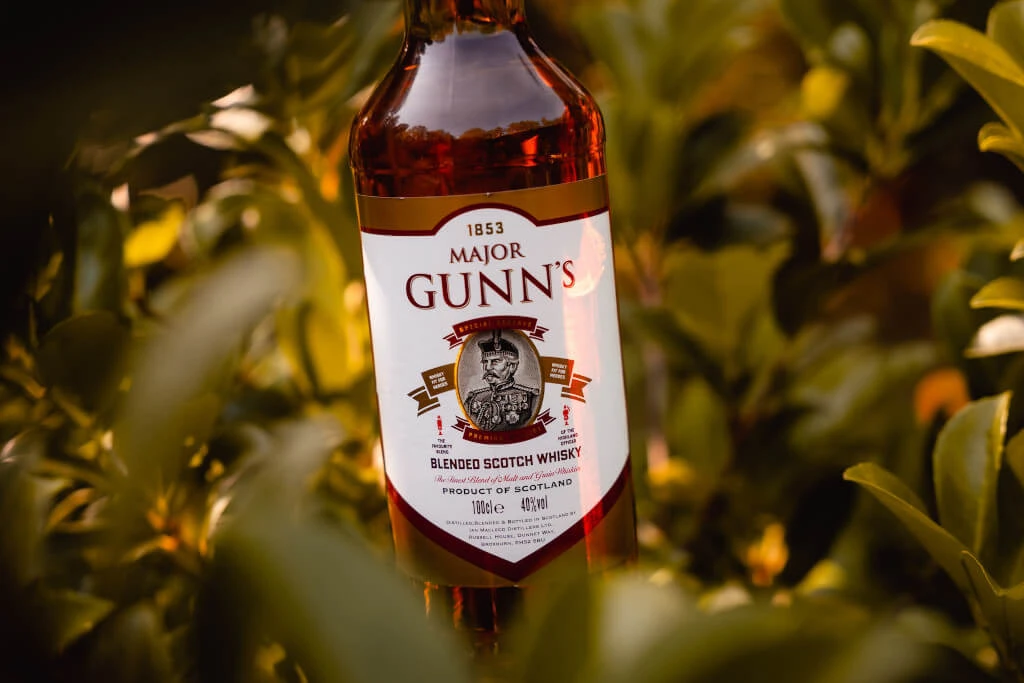Whisky, as we know it today, has undergone countless transformations since its inception. In the early days, the aging process wasn’t given the prominence it holds now. As whisky production techniques evolved, so did the appreciation for age. The maturation process, where whisky interacts with oak barrels, began to be seen not just as a necessary step but as an art form. Distillers recognized that prolonged interaction with wood endowed their spirits with nuanced flavors and a depth that couldn’t be replicated by any other means.
Nature’s Alchemy
When whisky is allowed to age, it undergoes a series of chemical reactions. The spirit extracts tannins, lignin, and other compounds from the oak, each contributing to the whisky’s flavor, aroma, and mouthfeel. As the years pass, evaporation leads to the “angel’s share” – a portion of the spirit that’s lost to the heavens, concentrating the remaining liquid and intensifying its character. It’s a natural, unhurried process that can’t be fast-tracked or replicated.
Older Whiskies
Each barrel of aged whisky is a time capsule, reflecting not just the interaction of spirit and wood, but also the specific conditions of its storage. Minute differences in temperature, humidity, and air quality over decades can result in vastly different flavor profiles, even for barrels stored side by side. This uniqueness is what makes older whiskies so coveted.
The Blending Debate

The debate around blending aged whiskies isn’t new; it has roots tracing back to the 19th century. As the demand for whisky grew, blending became a popular method to maintain consistency and meet consumer needs. Notably, it was around the mid-20th century when distillers and connoisseurs started valuing the unique character of single malts, especially those aged for extended periods.
Shift in Market Dynamics
In the 1980s and 1990s, the whisky market saw a significant upswing in the demand for aged single malt whiskies. Distilleries responded by marketing their older reserves, emphasizing their unique taste profiles and the expertise required to craft them.
Sir Richard Patterson, Master Blender at Whyte & Mackay, stated in an interview with “Whisky Advocate” in 2002:
“Aged whiskies, especially those beyond 30 years, have such unique profiles. They carry the legacy of their distillery. To blend them is to erase that history.”
This sentiment was echoed by Ian Logan, Global Brand Ambassador for The Glenlivet, who mentioned during a whisky-tasting event in 2010:
“When you have an old whisky, it’s like holding a piece of the past. Blending it would be akin to ripping pages out of an old, treasured book.”
The Counter Argument
Despite the respect for aged whiskies, there’s a segment of the industry that believes in the art of blending, regardless of the age of the whiskies. Jim Beveridge, Master Blender at Johnnie Walker, defended the practice during a discussion at the “World Whisky Summit” in 2015: “There’s an art to blending. We can take old whiskies and create blends that have a symphony of flavors, each complementing the other.”
The Debate in the Modern Era
The surge in demand for unique experiences has led many whisky enthusiasts to explore older whiskies. Blended-aged whiskies, though fewer in the market, have their niche following. The debate has been further intensified by online platforms and social media, where whisky enthusiasts and experts actively discuss and critique different brands and blends.
Rebecca Almqvist, Editor-in-Chief of “Whisky Chronicles,” observed in a recent editorial:
The debate around blending aged whiskies mirrors the broader discussion in the world of spirits. It’s about tradition versus innovation, history versus modernity.”
- Economics and Rarity: Liquid Gold From an economic standpoint, older whiskies command higher prices due to their scarcity. Each bottle represents a finite resource that’s no longer being produced. Blending aged whiskies diminishes its inherent value and reduces the stock of a non-renewable commodity. For collectors, each bottle of aged whisky holds not just the promise of a sensory experience but also an investment potential. Blending dilutes both.
- The Cultural Perspective: Respecting Legacy In cultures where tradition and heritage are valued, older whiskies are seen as liquid legacies. They represent a link to the past, a tangible connection to bygone eras, and the distillers who crafted them. To blend such a whisky is, in many ways, akin to erasing a piece of history. It’s a gesture that’s viewed, particularly in European circles, as disrespectful to the craft and the craftsmen.
- Taste and Complexity: A Symphony of Flavors On the palate, older whiskies offer unparalleled complexity. Layers upon layers of flavors, each unfolding sequentially, offer a tasting experience that’s meditative. The introduction of other whiskies into this mix, especially younger ones, disrupts this harmony.
The Unseen Consequences
If you’re considering the blending of aged whiskies, the art goes beyond just mixing spirits. It’s crucial to understand the repercussions of such decisions. If you are still not convinced that this is something to steer clear of, here’s why many master distillers steer clear of blending their vintage whiskies:
The Disruption of Flavor Profile

- Macallan 1926 Fine and Rare: Imagine owning a bottle of Macallan 1926 from the Fine and Rare collection. Aged for 60 years, this bottle fetched over a million dollars at an auction. Its uniqueness lies in its intricate flavor notes, ranging from orange-tinted oak to dried fruits spiced with clove. If you were to blend this whisky, you would risk overshadowing or outright eliminating these precise notes, making it indistinguishable from other, less distinct whiskies.
Dilution of Brand Value
- Balvenie DCS Compendium Chapter 4: A premium name in the whisky world, Balvenie unveiled five aged single malts ranging from 1971 to 2009. These bottles stand as an example of the brand’s commitment to the aging process. Now, if Balvenie decided to blend these, they would essentially be diluting the exclusivity and brand equity they’ve worked decades to build.
Historical Significance Overlooked
- Glenfiddich Janet Sheed Roberts Reserve 1955: A whisky of historical importance, it was named after Janet Sheed Roberts, the granddaughter of Glenfiddich’s founder. Only 11 bottles of this whisky exist, making it invaluable. Blending this would be akin to discarding a piece of the distillery’s legacy.
Inconsistent Aging Process Results
Every whisky barrel ages differently, even if they start identically. By blending:
- You compromise the unique maturation journey of each barrel.
- Two 30-year-old whiskies might taste drastically different based on where they were stored in the warehouse.
Factors to Remember When Contemplating a Blend
- Taste Variation: Even a slight variation in the source whiskies can create a blend that’s wildly inconsistent from one batch to the next.
- Barrel Influence: The type of barrel (e.g., American oak, European oak) and its previous contents (e.g., sherry, port) can substantially influence flavor. Merging different barrel influences can muddy these profiles.
- Economic Implications: As seen in the examples above, the monetary value of aged whiskies is vast. Blending could lead to a decrease in individual bottle value.
For anyone passionate about whiskies, especially the aged varieties, understanding the weight of blending decisions is paramount.
Where the Debate Stands Now
Despite the differing opinions, one thing is clear: the debate is far from over. While purists argue for the preservation of aged whiskies in their unblended form, innovators believe in the endless possibilities that blending offers.
While there’s no denying that some blends have achieved legendary status in the whisky world, when it comes to rare aged whiskies, the consensus among many connoisseurs is clear: let history speak for itself, undiluted and unblended.

